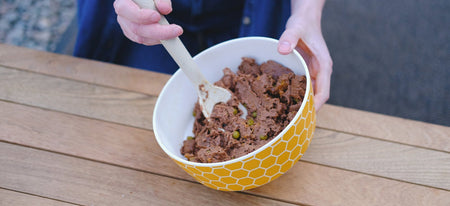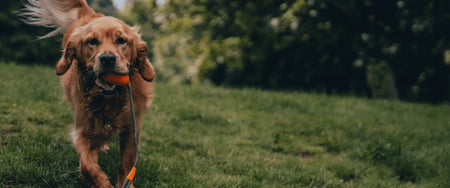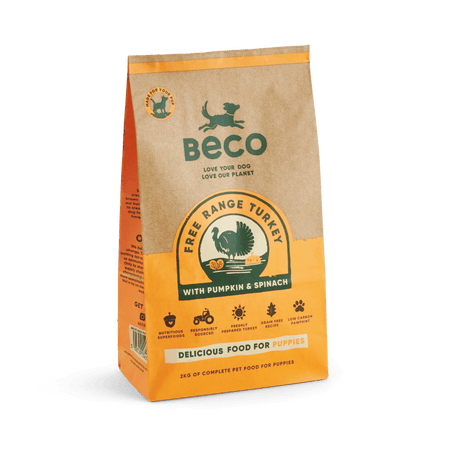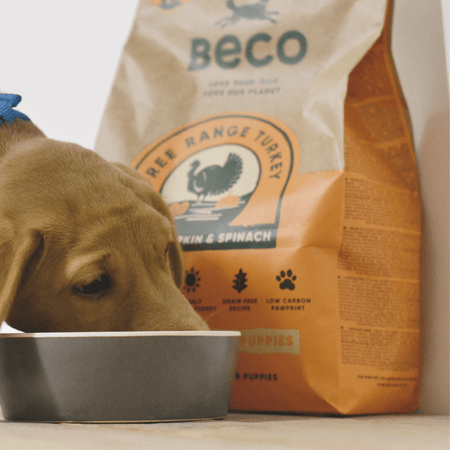Getting ready to welcome a new puppy into your home can be both an exciting and nerve-wracking time, especially if you’re a first-time owner.
Preparing for their arrival by puppy-proofing your house and stocking up on pup-friendly toys and treats can help make the transition easier, for both you and them. Picking the right type of food for your new furry friend, however, can be daunting, especially since there is so much choice out there.
Seeing as your dog will likely eat whatever they can find, you’ll have to do your own research into what is best for them and at what stage. But it’s something worth investing your time in as early nutrition plays a big part in a dog’s development of healthy muscles, bones and teeth. Encouraging healthy eating in the beginning will also set up good habits that will last into adulthood.
Our guide will help you make the best choice for your new pet, including the different benefits and uses of wet dog food.
What Should I Feed My Puppy?
All puppies are different and when it comes to feeding them, no one food is best. As your puppy grows, it may display signs of an allergy, so in this case feeding them a hypoallergenic diet.
As well as taking their individual needs into consideration, the size and breed of your dog are important factors when designing a diet. Due to the possible health risks, large-breed puppies should have diets with a lower fat and calorie content than those for smaller puppies.
Over the long term, experts disagree on whether feeding your dog dry food or wet food is best. There is as much debate on this subject as there is on which is superior: raw vs kibble dog food.
Where experts do agree, however, is that puppies have very particular nutritional needs because they are growing and developing so fast. Depending on their breed, dogs can reach adulthood in a speedy 9 to 24 months. As a result, young dogs need extra protein and essential vitamins, something adult dog food just can’t give them.
Puppies also need different foods depending on their stage on development. So, while wet food might not suit your pooch forever, it can be very useful at various life stages.
Weaning and the journey to solid food
Weaning refers to the natural process where a puppy goes from solely surviving on their mother’s milk to eating solid foods. It’s a process that begins between the age of 3 – 4 weeks and takes several weeks to complete. Puppies are fully weaned when they reach 8 – 10 weeks old.
To transition from milk to solid:
At 3-4 weeks begin by making gruel. This is a mushy substance about the consistency of porridge. It’s made by mixing milk replacer and water with a small amount of solid food, such as a kibble puppy food or a wet dog food.
When feeding this to your puppy, it might take them a few days to begin enjoying it. So start by placing the food on a flat saucer and just dipping their noses in it slightly 2-3 times a day, so they can begin to become accustomed to it.
Over the next 4-6 weeks, you will need to slowly reduce the amount of milk replacer and water, until they are eating a solid diet at around 8-10 weeks old.
In most scenarios, your dog would have already been weaned off milk by the time they come to live with you. If they arrive shortly after having been weaned, it’s best to start by feeding them food that is easy for them to chew and digest.
While you can feed your puppy moistened and mushed up dry food at this stage, wet food can be a better and more convenient choice.

Should I feed my 8 week old puppy wet food?
At 8 weeks old you can start feeding your pup wet dog food. Your puppy still has soft teeth, which can make wet food a better choice. Pups at this stage are finally transitioning from their mothers milk to solid food and wet dog food is perfect for this, as dogs often find it more palatable and easier to eat.
After this, once your puppy’s teeth have started to strengthen and harden, you can make the swap from wet to dry food, if you wish. When doing so, it can be helpful to soften the kibble by moistening it with water before feeding it to your puppy. It’s also best to make the transition slowly, ideally over a 10-day period: dogs stomachs are sensitive and can suffer from sudden dietary changes.
There is some debate over whether dry kibble is better for good dog dental health. Some argue that the crunch is essential for developing strong and healthy teeth. Others, however, claim that the fact that dry food stays stuck to their teeth can create decay and other problems.
Once you’re past the weaning stage, it really is down to personal choice – both yours and your pup’s!
What is wet dog food?
The fundamental difference between wet and dry food is the water content. Dry food has a moisture content of between 3 - 12%, while wet food is between 60 - 84% moisture.
Wet foods are either canned or sealed in pouches, while dry foods (otherwise known as kibble) usually come packaged in big waxed paper bags or packaged in cardboard boxes.
Whilst dry food brings many advantages in terms of ease of storage, price and cleanliness, wet dog food can be a good choice for puppies with poor appetites as the smell and texture is more likely to appeal.
What are the benefits of wet food for puppies
Wet food is a great choice for young puppies. Those who have only just developed their teeth and transitioned to solid foods can find it difficult to chew and swallow, so dry food can be a challenge. Because of its meaty texture and fragrant smell, this form of food can also appeal to fussy eaters.
For greedy or overweight dogs, wet food can also be a good choice as it has half the calories of a bowl of dry food.
The high moisture content also helps make sure your puppy takes in plenty of fluids, which can decrease the risk of urinary tract infections.
Dry food, on the other hand, packs a lot of nutrition into a much smaller package. Given you will be feeding your puppy around four meals a day up until the age of 4 months, this generally making it better value for money.
With its low water content, you can also store a lot more dry food in a small space, a real help if you have a large dog – or a small flat!
Final words
When it comes to choosing what to feed your puppy, wet food can be the perfect choice, especially for very young puppies just past the weaning stage. It might also be the most convenient option for you as the owner, and can save you from having to mush dry kibble into a soft consistency.
When it comes to what is healthiest, however, both types of dog food have their advantages and disadvantages, and neither is right or wrong. Ultimately, it’s what nutrients and ingredients are in the dog food rather than the form it takes that matters.
Provided the food you choose is of high-quality and packed full of nutrients, like our pet food, either wet or dry food (or a combination of the two) can help your pup grow into a healthy, strong and happy dog.













